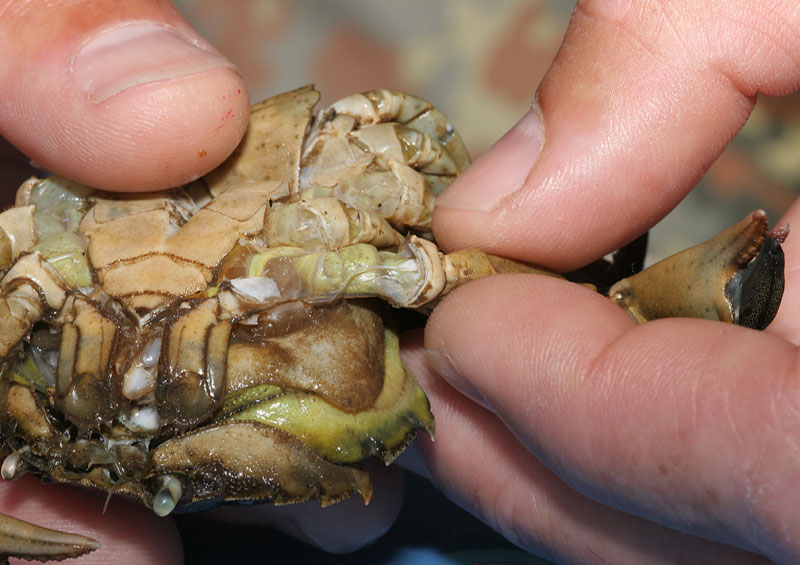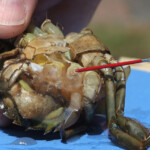In the second part of his peeler crab dossier Steve Walker deals with peeling, freezing and presenting this favourite fish-food.
Following on from the collection of the crabs, peelers that are ready be used have to first be prepared either for mounting on the hook or for freezing… and it’s a messy business whichever way you look at it. First, kill the crab first by piercing it between the eyes with a suitable pointed tool. Carefully twist off the legs and claws at the body, cleanly removing each whole appendage. Remove the top shell, the side shells, and then prise away the shell from underneath around the leg sockets, and then pull the shell from the abdominal flap.



Normally there will be some white shell matter between the leg segments: remove this, the hard eye sockets and mouth parts. Lastly lift each side of the soft body to reveal the dark coloured lungs. Carefully remove all of this material by cutting it away and the crab is ready for use.




Crab legs and claws are easy to peel, so long as they are ready, and make a good bait in their own right. Starting from the pointed end, pull each leg segment free… the whole leg can be extracted segment by segment.




Frozen peeler crab is a superb bait, and many anglers spend a considerable time preparing and freezing down prime crab. The first rule of thumb is only freezer top quality crabs; never be tempted to peel and freeze dead crabs because they make very poor baits by comparison. As soon as a crab dies the tissue starts to break down producing toxins, which fish can easily detect and avoid.
How to freeze your crabs
Once prepared as above, crabs need to be frozen as quickly as possible. The method that works for me involves first giving each crab a quick rinse in some fresh tap water to dislodge any small pieces of shell than may have gone unnoticed. Next, place them on some good absorbent tissue paper to dry for a minute, and lightly pat off any excess water. Now lay the crabs and the peeled legs on a sheet of metal or glass that has previously been placed in the freezer, and place back in the freezer for an hour or so. The cold base plate quickens the freezing process.


After an hour (less if you have a powerful freezer), remove the crabs from the freezer and tightly wrap the semi-frozen baits individually in cling film or tin foil. But don’t overdo it, as the crab needs to be frozen not insulated. Place the crabs back on the metal tray and in the freezer until properly frozen. Finally, pack dozen or so in a sandwich bags, and store in the freezer.
If you have a freezer cookery book that shows you how to freeze soft fruits such as raspberries etc, follow the instructions and treat the crabs the same. You will also pick up some tips on how to store frozen foods, such as not putting too many items together in the same container as this produces an insulating effect. And suck the air out of a sandwich bag via a straw before properly sealing it to avoid the same effect and prevent freezer burn.
Presenting a crab bait
For the likes of flounders and eels, a short shank hook such as the Kamasan B900C or Mustad Limerick improves presentation of a peeler bait, and stops the crab from sliding down the shank as it can on a Aberdeen pattern. However if you are using a crab with a worm cocktail, a longer shank hook is better. The Kamasan B950U or Mustad Vikings are classic crab hooks for bigger species such as cod and bass.
There are several ways to bait up with a crab. A whole crab of two to three inches across the back, will make a good big bait for bass and cod can be mounted whole by pushing the hook through the back of the body, then out through a front leg socket and secured with elastic thread. To make a juicier bait that releases its scent in a quick initial burst, simply cut the crab into two halves and mount both of them on the hook and secure with elastic thread. Additionally, a couple of peeled legs can be slid onto the point so the bait resembles a crab as well as smells like one.






A size 2 Kamasan B900C with half a section of a crab around an inch across makes a fine flounder and eel bait. Big fist-sized peelers can be cut to produce several small baits or used whole for bigger fish such as cod, bass, early season ray or smooth hound. Equally several smaller crabs can be bound together to produce a large meaty bait.
Remember to match the hook size to the size of the fish you expect to catch, and then match the bait to the size of hook size. And only use the minimum amount of elastic thread to secure the bait. When fishing in rivers, or short and gentle casting suffices, many anglers choose not use any thread at all. They simply stitch the hook in-and-out the leg sockets to produce a very natural looking bait.
Fresh, frozen and cocktailed
When match fishing where sport is expected to be fast, anglers often use only frozen crab baits, as peeling a sufficient quantity of fresh crab to constantly bait up a two or three hook rig is too time consuming and inefficient. Frozen crab tends to wash out slightly quicker than fresh crab, but is no less successful, and sometimes a quick release of juices produces instant bites.
Peeler crab is the only bait to use for cod during the summer months along the North East coast and in many other areas. Indeed, when those red-coloured cod are established in the kelp beds, they are rarely taken on any other bait. Coalfish, pollack, and wrasse are other regular species coming to crab from rock edges. Crab remains top of the menu well into October and November, after which, worm baits come to the fore.


Crab is a good base for any cocktail bait, especially where cod are concerned. Crab / mussel is a classic northern cod cocktail, with the addition of a couple of mussels also serving to bulk the bait out when crab is in short supply. Lugworm / crab, ragworm / crab, crab / white rag, or crab / razor clam are all very effective winter baits in my local area, while small worm baits tipped with a few peeler legs can often produce some big bags of dabs and flounders from the local piers.
Why do crabs walk sideways?
 Fish-brain says: It is down to the way that their legs bend. Muscles work in pairs and can only retract or extend. One muscle relaxes and is then pulled back by the second muscle to produce movement.
Fish-brain says: It is down to the way that their legs bend. Muscles work in pairs and can only retract or extend. One muscle relaxes and is then pulled back by the second muscle to produce movement.
The muscle pairs in crabs are attached to the inner surface of the skeleton including the legs and claws. Crabs do not have ball and socket joints like humans, rather their legs pivot at numerous push-in socket joints that are sealed by a flexible membrane, allowing movement in one plane.
Each joint on a leg however, moves in a different plane, and when coordinated to work together certain crab species can move in all directions. Some crabs such as the common shore crab have joints in their legs which don’t cover all planes of movement so that they can only move sideways in order to avoid the legs getting tangled with each other.


































